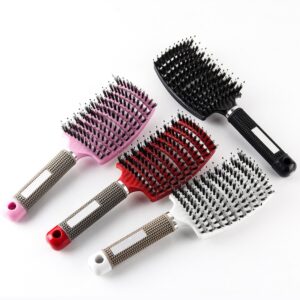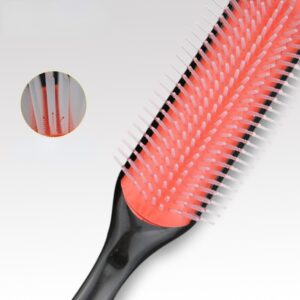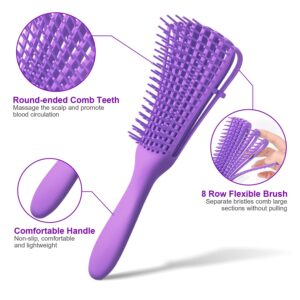Finding the Perfect Detangling Hair Brush
Say Goodbye to Knots and Tangles!

Are you tired of battling with knots and tangles every time you brush your hair? Look no further! In this guide, we will help you find the perfect detangling hair brush that will make your hair care routine a breeze. With our expertise in the world of hair care, we have curated a comprehensive selection of the best detangling hair brushes on the market. Whether you have thick, curly locks or fine, straight hair, we have got you covered.
Our guide will walk you through the key features to look for when choosing a detangling hair brush, such as bristle type, handle grip, and ergonomic design. We will also highlight the benefits of different brush materials and discuss how they can impact your hair health. Additionally, we will share useful tips and techniques to properly detangle your hair without causing damage or breakage.
Say goodbye to painful tugging and hello to smooth, knot-free locks! So, get ready to transform your hair care routine with our ultimate guide to finding the perfect detangling hair brush. Say goodbye to knots and tangles once and for all!
The Importance of a Detangling Hair Brush
 A detangling hair brush is a must-have tool for anyone who wants to keep their hair healthy and manageable. Detangling hair brushes are designed to gently separate the knots and tangles that can form in your hair, especially if you have curly, wavy, or thick hair.
A detangling hair brush is a must-have tool for anyone who wants to keep their hair healthy and manageable. Detangling hair brushes are designed to gently separate the knots and tangles that can form in your hair, especially if you have curly, wavy, or thick hair.
Detangling hair brushes can prevent hair breakage, reduce frizz, and improve the appearance of your hair. They can also stimulate blood circulation in your scalp, which can promote hair growth and health. Here are some of the benefits of using a detangling hair brush regularly:
- It saves you time and hassle. A detangling hair brush can glide through your hair easily, without pulling, snagging, or ripping your hair. You can detangle your hair in minutes, instead of spending hours trying to comb through the knots with a regular brush or comb.
- It protects your hair from damage. A detangling hair brush has flexible bristles that can bend and adapt to the shape of your hair, instead of forcing it to conform to the brush. This reduces the stress and tension on your hair strands, which can cause split ends, breakage, and hair loss.
- It enhances your hair’s natural beauty. A detangling hair brush can smooth out the cuticles of your hair, which are the outer layers that protect your hair from environmental factors. Smooth cuticles reflect more light, making your hair look shiny and glossy. They also prevent moisture from escaping, keeping your hair hydrated and soft.
- It boosts your scalp health. A detangling hair brush can massage your scalp gently, which can increase blood flow and oxygen delivery to your hair follicles. This can stimulate hair growth and prevent scalp problems such as dandruff, itchiness, and inflammation.
A detangling hair brush is a simple but effective way to improve your hair care routine. By using a detangling hair brush regularly, you can enjoy having healthy, beautiful, and tangle-free hair.
Different Types of Detangling Hair Brushes
If you have ever struggled with tangled hair, you know how frustrating and painful it can be to detangle it. Fortunately, there are different types of detangling hair brushes that can make your life easier and your hair healthier. Here are some of the most common ones and how they work:
- Wide-tooth comb: This is a simple and versatile tool that can gently separate knots and smooth out your hair. It is especially good for curly, coily, or wavy hair, as it does not disrupt the natural curl pattern. You can use it on wet or dry hair, but make sure to start from the ends and work your way up to the roots.
- Paddle brush: This is a large, flat brush that has a cushioned base and flexible bristles. It is ideal for long, straight, or fine hair, as it can detangle large sections of hair without pulling or breaking it. It also helps to distribute the natural oils from your scalp to the ends of your hair, adding shine and softness. You can use it on wet or dry hair, but be gentle and avoid brushing too hard.
- Tangle teezer: This is a small, ergonomic brush that has short, cone-shaped bristles that glide through your hair without snagging or tugging. It is great for all hair types and textures, as it can detangle even the most stubborn knots without causing damage or frizz. It also massages your scalp and stimulates blood circulation, which can promote hair growth. You can use it on wet or dry hair, but make sure to hold it close to your scalp and brush in short strokes.
- Wet brush: This is a specially designed brush that has thin, flexible, and coated bristles that can detangle wet hair without causing breakage or split ends. It is perfect for fine, fragile, or damaged hair, as it can gently glide through your hair without pulling or stretching it. It also helps to prevent hair loss and reduce stress on your scalp. You can use it on wet or dry hair, but avoid brushing too much when your hair is wet, as it is more prone to damage.
Factors to Consider when Choosing a Detangling Hair Brush
A detangling hair brush is a tool that can help you remove knots and tangles from your hair without causing damage or breakage. However, not all detangling hair brushes are created equal. There are several factors that you should consider when choosing a detangling hair brush for your hair type, texture, and condition. Here are some of them:
- The shape and size of the brush. The shape and size of the brush affect how well it can glide through your hair and reach all the areas that need detangling. A round or oval brush is ideal for curly or wavy hair, as it can follow the natural shape of your curls and prevent frizz. A paddle or rectangular brush is suitable for straight or fine hair, as it can provide more tension and control. The size of the brush should match the length and thickness of your hair. A large brush can cover more surface area and save time, but a small brush can be more precise and gentler.
- The material and design of the bristles. The material and design of the bristles determine how smooth and comfortable the brushing experience will be. Natural bristles, such as boar or nylon, are soft and flexible, and can distribute natural oils along your hair shafts, making your hair shiny and healthy. Synthetic bristles, such as plastic or metal, are stiff and rigid, and can create static electricity, making your hair frizzy and dry. The design of the bristles also matters. Bristles that are widely spaced, staggered, or looped can easily slide through knots and tangles without pulling or snagging. Bristles that are densely packed, aligned, or pointed can cause more friction and tension, leading to breakage and split ends.
- The handle and weight of the brush. The handle and weight of the brush affect how comfortable and ergonomic the brushing process will be. A handle that is long, wide, or cushioned can provide a better grip and leverage, making it easier to manoeuvre the brush through your hair. A handle that is short, narrow, or hard can cause hand fatigue and strain, making it harder to control the brush. The weight of the brush should also be balanced and proportionate to the size of the brush head. A heavy brush can add more pressure and force to your hair, while a light brush can be gentler and more delicate.
Tips for Using a Detangling Hair Brush Effectively
A detangling hair brush is a useful tool for managing tangled or knotted hair. However, using it incorrectly can cause more damage to your hair and scalp. Here are some tips for using a detangling hair brush effectively:
- Choose the right brush for your hair type. Different brushes have different bristles, shapes and sizes that suit different hair textures and lengths. For example, a wide-toothed comb is good for curly or coarse hair, while a paddle brush is good for straight or fine hair.
- Detangle your hair when it is wet or damp. Wet hair is more flexible and less prone to breakage than dry hair. You can also apply a leave-in conditioner or a detangling spray to help smooth out the knots and reduce friction.
- Start from the ends and work your way up. Do not pull the brush from the roots to the tips, as this can cause more tangles and damage. Instead, start from the bottom of your hair and gently work your way up in small sections, using short strokes.
- Be gentle and patient. Do not yank or force the brush through your hair, as this can cause pain, split ends and hair loss. If you encounter a stubborn knot, use your fingers to loosen it first, then use the brush to comb it out. Take your time and be gentle with your hair.
- Clean your brush regularly. A dirty brush can harbor bacteria, dirt and oil that can transfer to your hair and scalp. To clean your brush, remove any hair strands from the bristles, then wash it with warm water and mild soap. Rinse it well and let it air dry.
How to Care for and Clean your Detangling Hair Brush
A detangling hair brush is a useful tool for managing tangled or knotted hair, but it also needs proper care and cleaning to keep it in good condition. Here are some steps to follow to maintain your detangling hair brush:
- After each use, remove any hair strands that are stuck in the bristles. You can use your fingers, a comb, or a toothpick to gently pull them out.
- Once a week, wash your detangling hair brush with warm water and mild soap. You can also add a few drops of vinegar or baking soda to help disinfect and deodorize the brush. Rinse well and shake off the excess water.
- Dry your detangling hair brush with a clean towel or let it air dry on a flat surface. Avoid using a hair dryer or exposing the brush to direct heat, as this can damage the bristles or the handle.
- Store your detangling hair brush in a cool and dry place, away from direct sunlight or moisture. You can also use a protective case or bag to keep it clean and dust-free.
- Replace your detangling hair brush every six months or when you notice signs of wear and tear, such as loose or broken bristles, cracks, or stains.
By following these simple steps, you can extend the life of your detangling hair brush and enjoy smooth and shiny hair every day.
DIY Alternatives to Detangling Hair Brushes
If you don’t have a detangling hair brush, don’t worry. There are some DIY alternatives that you can use to get rid of those pesky knots and tangles. Here are some of them:
- A wide-tooth comb. This is the simplest and most common alternative to a detangling brush. A wide-tooth comb has more space between the teeth, which reduces the friction and pulling on your hair. You can use a wide-tooth comb on wet or dry hair, but make sure to start from the ends and work your way up to the roots.
- A paddle brush. A paddle brush has a large, flat surface that can cover more area of your hair. It also has flexible bristles that can glide through your hair without snagging or breaking it. A paddle brush is best for straight or wavy hair, and it can also help smooth out frizz and flyaway.
- A boar bristle brush. A boar bristle brush is made of natural fibres that are gentle on your hair and scalp. It can distribute the natural oils from your scalp to the ends of your hair, which adds shine and moisture. A boar bristle brush is ideal for fine or thin hair, and it can also stimulate blood circulation and promote hair growth.
- A T-shirt or a towel. If you don’t have any of the above brushes, you can still detangle your hair with a T-shirt or a towel. Simply wrap your hair in a T-shirt or a towel after washing it, and gently squeeze out the excess water. Then, use your fingers to separate your hair into sections and gently detangle each section. This method can also reduce frizz and damage caused by rubbing your hair with a regular towel.
Conclusion: Finding the Perfect Detangling Hair Brush for your Hair Type

A detangling hair brush can make a huge difference in the health and appearance of your hair. But not all brushes are created equal, and you need to find the one that suits your hair type and needs. We have reviewed some of the best detangling hair brushes on the market, and given you some tips on how to use them effectively. Whether you have fine, thick, curly, or kinky hair, there is a perfect detangling hair brush for you.
We hope that this guide has helped you narrow down your options and find the best brush for your hair. Remember to always be gentle with your hair, use a good conditioner, and detangle your hair when it is wet or damp. With the right detangling hair brush, you can enjoy smooth, shiny, and healthy hair every day.
